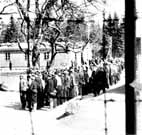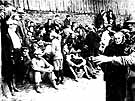
|
|
|

|

|

|

|
|
Click on an image to see a larger, more detailed picture.
|
|
|
|
|
| 1942: The "Final Solution" |

|
pg. 385 |

|
|
|
|
| |
 Jewish inmates at the concentration camp in Berg, Norway, line up for roll call after being arrested on October 25, 1942. Almost all male Jews who were arrested during this phase of the deportation process were brought to this camp before being sent to Auschwitz. The main deportation of Norwegian Jewry was carried out on November 26, 1942.
Jewish inmates at the concentration camp in Berg, Norway, line up for roll call after being arrested on October 25, 1942. Almost all male Jews who were arrested during this phase of the deportation process were brought to this camp before being sent to Auschwitz. The main deportation of Norwegian Jewry was carried out on November 26, 1942.
Photo: Norges Hjemmerfrontmuseum / United States Holocaust Memorial Museum Photo Archive
|
 Jews from the Tomaszów Mazowiecki Ghetto were transported to the Treblinka death camp, and were among the first Jews to die in the camp's new gas chambers. The new units had a capacity of 3800, an "improvement" over the three original chambers, which could hold 600 people at one time.
Jews from the Tomaszów Mazowiecki Ghetto were transported to the Treblinka death camp, and were among the first Jews to die in the camp's new gas chambers. The new units had a capacity of 3800, an "improvement" over the three original chambers, which could hold 600 people at one time.
Photo: United States Holocaust Memorial Museum Photo Archive
|
 Jews from Chmielnik (Poland) were forced into a ghetto in March 1940. The subsequent overcrowding was exacerbated because Jews from beyond the region of Chmielnik were sent to the ghetto, as well. Here, Chmielnik Jews are loaded into open boxcars for deportation to Treblinka in the fall of 1942. Earlier in the year, from August 20 to 24, 21,000 of the region's Jews were shipped to Treblinka, where they died in the gas chambers.
Jews from Chmielnik (Poland) were forced into a ghetto in March 1940. The subsequent overcrowding was exacerbated because Jews from beyond the region of Chmielnik were sent to the ghetto, as well. Here, Chmielnik Jews are loaded into open boxcars for deportation to Treblinka in the fall of 1942. Earlier in the year, from August 20 to 24, 21,000 of the region's Jews were shipped to Treblinka, where they died in the gas chambers.
Photo: YIVO / United States Holocaust Memorial Museum Photo Archive
|
|

|

|

|

|
 November 1-6, 1942: More than 170,000 Jews are killed within one week at the Belzec, Auschwitz, and Treblinka death camps.
November 1-6, 1942: More than 170,000 Jews are killed within one week at the Belzec, Auschwitz, and Treblinka death camps.
|
 November 2, 1942: In the Lithuanian town of Marcinkance, 370 Jews who refuse to board trains for deportation bolt for the ghetto boundaries. In the melée that follows, 360 Jews and many guards are killed. Between deaths and successful escapes, not one Jew is left to board the trains.
November 2, 1942: In the Lithuanian town of Marcinkance, 370 Jews who refuse to board trains for deportation bolt for the ghetto boundaries. In the melée that follows, 360 Jews and many guards are killed. Between deaths and successful escapes, not one Jew is left to board the trains.
|
 November 2, 1942: In Zolochev, Ukraine, the chairman of the Jewish Council is murdered by Germans after refusing to sign a paper saying that the liquidation of the ghetto was necessitated by the spread of a typhus epidemic. 2500 Zolochev Jews, including poet S. J. Imber, are deported to Belzec.
November 2, 1942: In Zolochev, Ukraine, the chairman of the Jewish Council is murdered by Germans after refusing to sign a paper saying that the liquidation of the ghetto was necessitated by the spread of a typhus epidemic. 2500 Zolochev Jews, including poet S. J. Imber, are deported to Belzec.
|
 November 2, 1942: More than 100,000 Jews remaining in the towns and villages in the Bialystok region of Poland are arrested and deported to holding camps at Zambrów, Volkovysk, Kelbasin, and Bogusze before being sent to the Auschwitz and Treblinka death camps.
November 2, 1942: More than 100,000 Jews remaining in the towns and villages in the Bialystok region of Poland are arrested and deported to holding camps at Zambrów, Volkovysk, Kelbasin, and Bogusze before being sent to the Auschwitz and Treblinka death camps.
|
|
|
|
|
| 1942: The "Final Solution" |

|
pg. 385 |

|
|
The Holocaust Chronicle
© 2009 Publications International, Ltd.
|
|
